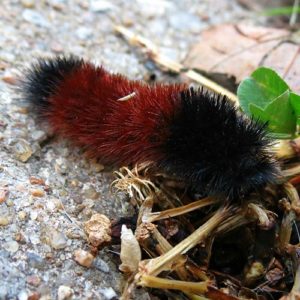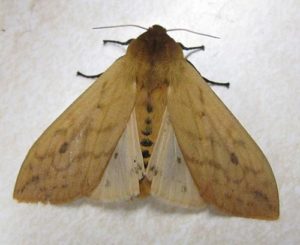Overview
Woolly worms, also known as woolly bears, may be our most familiar and well-recognized moth caterpillar. Every fall we see them steadily marching across driveways and streets in search of a place to spend the winter. And every year, predictions are made about what the upcoming winter is going to be like based on the color patterns that the woolly worms display.
What’s in a Name?
Woolly worms or woolly bears are the caterpillar of the Isabella tiger moth (Pyrrharctia isabella). Whether you call them woolly worms or woolly bears may depend on where you grew up or where you currently live. People in the south tend to call them woolly worms. People in the north tend to call them woolly bears.

What do Woolly Worms / Woolly Bears Look Like?
Woolly worms are covered by stiff bristles that give the caterpillar its distinctive woolly appearance. The bristles on both ends of the caterpillar are dark brown or black, while the bristles in the middle of the caterpillar are a rich, reddish-brown color. The color pattern is reminiscent of a chocolate Oreo. The proportion of dark bristles to lighter bristles can vary from one individual to another.
There are also quite a few different species of tiger moths, and many of their caterpillars look very similar to woolly worms. These other species may be all brown, all yellow, all black, or some other combination of light and dark bristles. It is easy to assume they are just another color variation of a woolly worm. (Some of those other species even have “woolly bear” as part of their common name, which just adds to the potential confusion.) However, when we are talking about the caterpillars associated with predicting the weather, then they will always have that banded, Oreo-like pattern.
Woolly Worm / Woolly Bear Defense Mechanisms
Unlike the bristles of many caterpillars, woolly worm bristles won’t sting you and most people can pick the caterpillars up without any problem. The woolly worm’s primary defense is to curl up in a tight ball when disturbed.
Woolly Worm / Woolly Bear Life History

The Isabella tiger moth is a drab moth that only lives for a few weeks as an adult. It doesn’t eat as an adult. Its sole purpose is to mate and lay eggs that will hatch into the next generation of caterpillars. The caterpillar is much better known than the adult moth because of the folklore associated with the caterpillar’s ability to predict the weather for the upcoming winter.
Woolly worms are generalist feeders which means they eat a wide variety of plants, including grasses and the leaves of several types of trees. Isabella tiger moths can have multiple generations each summer. That is why we sometimes find woolly worms in the late spring or summer. However, it is the last generation of the season that everyone notices and cares about.
In late fall, woolly worms go through a wandering period that is most noticeable as they cross sidewalks and roads. Eventually, the woolly worm burrows into the leaf litter or crawls under a log, piece of bark, or rock. They’ll hibernate in that location over the winter. Providing the woolly worms with a place to overwinter is a good reason not to rake all of your leaves if you can avoid it. In the spring the woolly worms emerge, eat for a few days, then use their bristles to spin a cocoon. After about a month, the adult Isabella tiger moth emerges from the cocoon.
The Folklore
Folklore states that each of the woolly worm’s 13 body segments represents one of the 13 weeks of winter. The head represents the beginning of the winter, while the tail represents the end of the winter. If the bristles on a segment are dark, then that week of winter will be colder and snowier than normal. Light-colored bristles on a segment represent a milder than normal week.
The folklore has existed for hundreds of years, but its popularity exploded in the late 1940s and 1950s. During that time, the insect curator for New York City’s American Museum of Natural History was friends with a journalist for The New York Herald Tribune. They made annual fall pilgrimages with their families to Bear Mountain State Park in New York. While there, they would collect Isabella tiger moth caterpillars and count the number of light-colored segments. (Other similar looking tiger moth caterpillars, such as species that are all black or all yellow, didn’t count.) The journalist friend published their findings as winter weather forecasts. Other newspapers picked up the reports, and the folklore spread.
The Science
There is no scientific evidence that the amount of black on a woolly worm has any correlation to the severity of the upcoming winter. Instead, the amount of brown compared to black is partially due to individual genetic variation, and partially an indication of the caterpillar’s age. Older caterpillars (ones that are in the later instars or have gone through more molts) tend to have broader brown bands.
Just for Fun
Despite the fact that the folklore isn’t backed up by science, it is still fun to look at the woolly worms each fall and try to make predictions for the upcoming winter. You can easily do this around your home or neighborhood. It can even be a fun activity to do with friends and family.
If you really want to get into the woolly worm fun, several places across the country have woolly worm festivals each fall. The largest ones that I know about are in North Carolina, Ohio, and Kentucky. I’m sure there are others that could probably be found through an internet search. These festivals usually take place sometime in October.

Backyard Ecology: Exploring Nature in Your Backyard
Nature isn’t just “out there.” It’s all around us, including right outside our doors. Hi, my name is Shannon Trimboli, and I am the host of Backyard Ecology. I live in southcentral Kentucky and am a wildlife biologist, educator, author, beekeeper, and owner of a nursery specializing in plants for pollinators and wildlife conservation. I invite you to join me as we ignite our curiosity and natural wonder, explore our yards and communities, and improve our local pollinator and wildlife habitat. Learn more or subscribe to my email list at www.backyardecology.net.

Leave a Reply